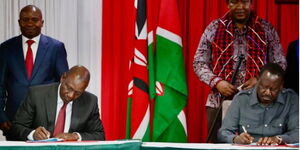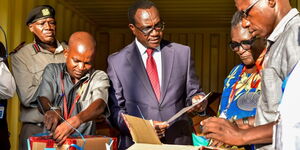Kithure Kindiki's return as the Cabinet Secretary for the Ministry of Interior and National Administration has thrust him into the eye of a storm. The seasoned politician was sworn in this morning, just as Nairobi and the country prepare for what might be the largest protests the city has ever seen.
Kindiki, who was previously criticised for his perceived indifference to police brutality during recent anti-government demonstrations, now finds himself at the forefront of a critical challenge. Protest organisers have issued a bold call for up to five million participants to flood the streets of the capital, setting the stage for a major confrontation with the authorities.
The scale of the upcoming protests is staggering. Intelligence reports predict that the city could see up to two million people on the streets, a figure that dwarfs previous demonstrations.
On June 25, during the peak of the anti-Finance Bill protests, around one million people took to the streets, leading to violent clashes that saw the perimeter wall of the Parliament Buildings breached and several protesters killed.
The stakes are high for Kindiki, who must now navigate a complex and volatile situation. Human rights organisations have reported a grim tally of at least 60 deaths due to police actions and numerous abductions since mid-June.
These figures paint a disturbing picture of the alleged abuse of power by security forces, including at least 34 people who have been reportedly abducted and tortured.
"The scale of these protests and the previous government's handling of the situation are deeply concerning," said a representative from the Kenya National Commission on Human Rights (KNCHR).
"The fears of many citizens, particularly those who protested against the Finance Bill, are palpable. They now live under a cloud of fear."
The protest organisers have framed their movement as a response to what they describe as government-sanctioned violence and state repression.
Posters circulating online have compared their cause to the Egyptian Tahrir Square protests of 2011, emphasising their demand for change. One such poster reads, "Weekly street protests are costing us lives. our people are being murdered and abducted daily."
Kindiki, during his vetting by the National Assembly's Committee on Appointments, defended his past actions and clarified his role. He stated that the police service operates independently under the guidance of the Inspector General and that his role is limited to providing policy directions.
"The reason I didn't speak more during the protests was because those events were primarily operational," Kindiki explained.
"As outlined in Article 25 of the Constitution, the Interior CS's role is to offer policy guidance. The Inspector General commands the police independently, and directives can only come from the CS on policy issues and from the Director of Public Prosecutions on investigations."
Despite acknowledging the deaths and arrests during the protests, Kindiki praised the police for their efforts, asserting that it is the responsibility of the Independent Policing Oversight Authority (IPOA) to address cases of excessive force by officers.
As Nairobi gears up for the anticipated mass mobilisation, Kindiki's actions will be closely scrutinised. The success or failure of his approach to managing the protests could shape not only his tenure but also the future of public dissent in Kenya.












